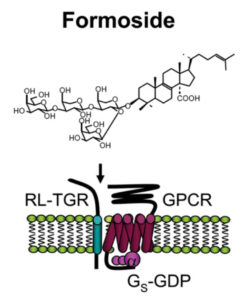
About
Marine sponges produce chemical compounds to deter predation by herbivorous fish. Two sponges, Erylus formosus and Ectyoplasia ferox, are interesting because the chemical deterrents they produce are triterpene glycosides. These deterrents, one of which is formoside, deter feeding by a wide range of fish. Formoside deters coral reef fish, as expected, and also deters freshwater fish like zebrafish, despite the fact that zebrafish would not normally encounter. The gene of the receptor for formoside was identified in a zebrafish cDNA library. The protein encoded by this gene is similar to receptor activity modifying proteins (RAMPs), because its activation results in a signal cascade that stems from a G-protein coupled receptor (GPCR) that has yet to be identified . As such, it was termed RL-TGR, for RAMP-like triterpene glycoside receptor . Although evidence suggests that this is the target of formoside, it has not been extensively studied in reef fish, and its associated GPCR is still unknown.
We are studying RL-TGR to learn more about fish chemoreception pathways. We are using molecular biology techniques to determine whether chemoreception is due to taste or olfaction, and to identify anatomically where RL-TGR is expressed. We also identifying the GPCR or multiple GPCRs that associate with RL-TGR to initiate the chemoreception pathway. We can also investigate whether chemoreception of other chemical defenses activate similar pathways, through RL-TGR-like and RAMP-like co-receptors of GPCRs. This research project, which is specific to chemoreception of sponge chemical defenses, will help us to understand the chemical ecology and the behavioral ecology of marine environments.